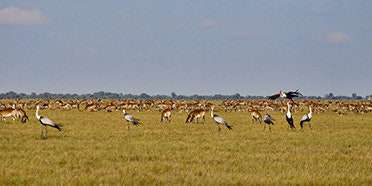- You are here:
- Home
- Countries & Parks
- Zambia Parks
- Lochinvar National Park
- Reviews
- Expert Reviews
Expert Reviews – Lochinvar NP

Emma is an award-winning travel writer for Rough Guides, National Geographic Traveller, Travel Africa magazine and The Independent.
1 person found this review helpful.
Lonely marshlands beside the Kafue River
The Scottish cattle farmer who gave Lochinvar its name in the 1900s managed to wipe out most of the large mammals in this region and, despite more recent conservation and rehabilitation efforts, the situation has never really recovered. Like its near-neighbour Blue Lagoon National Park, Lochinvar is no match for Kafue National Park, which dominates this part of Zambia. However, it’s good for birding, and birdwatchers who make the effort to get here will find conditions more comfortable and more fruitful than in Blue Lagoon.
Few do make the trip, though, and the park felt spectacularly empty when I visited, so it’s a good choice for those who enjoy a little solitude on safari. It’s also good for those who enjoy watching antelopes – with few predators around apart from opportunistic villagers, the Kafue lechwe seem to be flourishing.

Philip is an acclaimed travel writer and author of many guidebooks, including the Bradt guides to Uganda, Tanzania, Kenya and South Africa.
1 person found this review helpful.
Dry scrub and lush wetlands
Lochinvar is a national park of two halves: the dusty, scrubby bit to the south, and the wet bit to the north.
Coming by road from Monze (a junction town about 30 minutes’ drive from the entrance gate), you’ll drive for about 40km through a tract of dry grassland and miombo woodlands that is studded with termite mounds and supports sparse wildlife populations. Here we saw vervet monkey, baboon, common duiker and greater kudu. It is also reputedly still home to large numbers of spotted hyena.
This dusty road eventually brings you to the papyrus-lined southern shore of the Chunga Lagoon, which forms part of the Kafue Flats, a vast network of channels, islands, open lakes and seasonal floodplains fed by the Kafue River. This is one of the best sites in Zambia for aquatic birds. Driving as far as we could along the shore, then walking on further, we saw large flocks of glossy ibis, spur-winged goose and open-billed stork, and ticked off dozens of other species, of which African pygmy-goose seems to be especially common. Other interesting birds included Hartlaub’s babbler, swamp flycatcher (at the very southern end of its range), western marsh harrier and copper-tailed coucal. We also saw a few herds of Kafue lechwe, a striking semi-aquatic antelope that is near-endemic to the Kafue Flats, though these were far less numerous than in Blue Lagoon National Park (Lochinvar’s northern counterpart), and relatively unapproachable.
A disappointing aspect of this national park is that, following the closure of its only lodge a few years back, it is not possible to take a boat out onto the lagoon. This means you're unlikely to encounter any hippos or crocodiles, nor to see the large flocks of pelican, flamingo or African skimmer for which the park is famed.
As with Blue Lagoon, Lochinvar is a niche destination that is highly recommended to bird-watchers (for whom it is an easy day diversion from the main road between Lusaka and Livingstone), but unlikely to hold much appeal to other visitors.

Alan is a travel writer and author of over 20 Lonely Planet guidebooks, including the guides to Southern Africa and Zambia & Malawi.
2 people found this review helpful.
The Kafue Flats
This small park is well off-the-beaten track with no facilities (although camping is possible) so come well prepared. Consisting mainly of grasslands and a lagoon which floods during the Wet season this area has been deemed a World Heritage Site - the Kafue Flats. Large wildlife is still a bit scarce as the park is recovering from years of neglect.
Birdwatching is a draw and wetland birds are a highlight. I saw a few cranes and plenty of antelope - especially the Kafue lechwes splashing about in the shallows. Otherwise I heard the unmistakable grunt of hippos surfacing and saw a jackal sneaking around. If the wildlife is not cooperating you can scratch around the remnants of an Iron Age settlement or check out the scalding water of a hot spring, too hot to dip a toe in though.

Ariadne is a renowned African wildlife photographer whose work is featured in many well-known guidebooks and magazines.
3 people found this review helpful.
Birding in the Kafue Flats
Lochinvar National Park is a highly rated birding destination. It protects a section of the Kafue Flats, a massive seasonal floodplain of the Kafue River. As there is nowhere to stay inside the park, we based ourselves at Moorings Campsite, about 50km from the entrance. Once inside the park, you need to follow a long dusty road (passing a working gypsum mine) to get to Chunga Lagoon – the main birding hot spot. Here we were rewarded with a great variety of water-associated birds. Walking and bird watching along the papyrus fringed shore, we also spotted a herd of Kafue lechwe, a near-endemic restricted to the Kafue Flats. The only other place you might see this semiaquatic antelope is Blue Lagoon NP. We checked out Lochinvar’s other places of interest including a big baobab tree and hot springs, but we were disappointed there was no opportunity to get onto the wetland by boat or mokoro. All in all, the park feels quite neglected and, while I’m sure the wetlands are brimming with life, we couldn’t see much of it.


 Zambia Parks
Zambia Parks